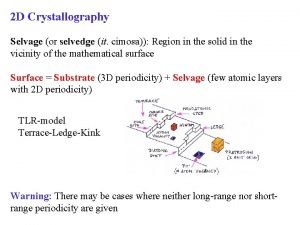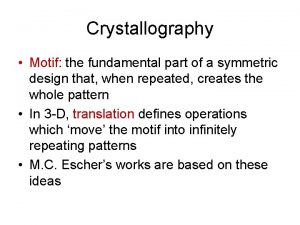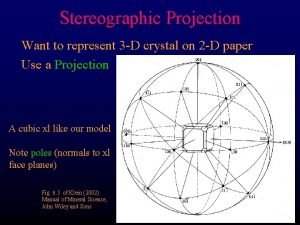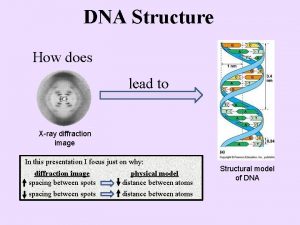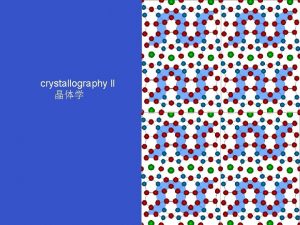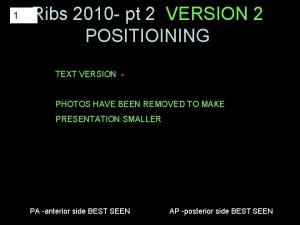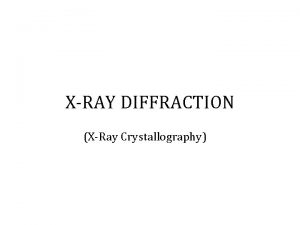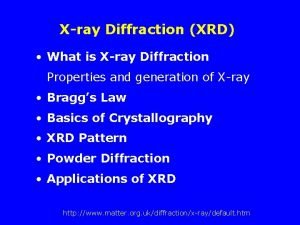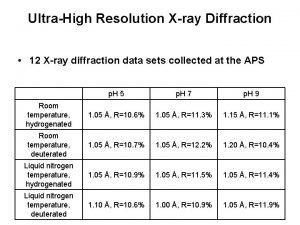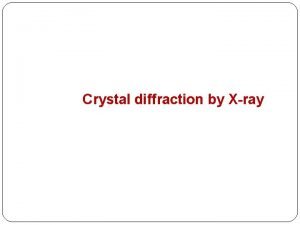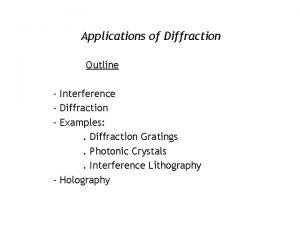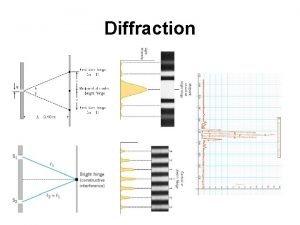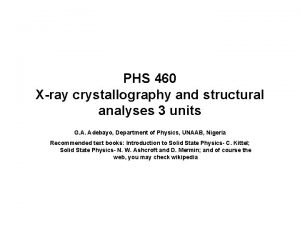CHE20031 Structural Inorganic Chemistry Xray Diffraction Crystallography lecture




























- Slides: 28

CHE-20031 (Structural Inorganic Chemistry) X-ray Diffraction & Crystallography lecture 1 Dr Rob Jackson LJ 1. 16, 01782 733042 r. a. jackson@keele. ac. uk www. facebook. com/robjteaching Twitter: #che 20031

Resources • Textbook: ‘Shriver & Atkins: Inorganic Chemistry 5 th edition’ (Atkins, Overton, Rourke, Weller & Armstrong) OUP, ISBN 978 -0 -19 -923617 -6 • Web resources: – Many! – Links on FB teaching page or in lecture notes. A particularly good site is: http: //www. doitpoms. ac. uk/ che-20031: XRD & Crystallography lecture 1 2

Lectures and Workshops • 11 th February, 17: 00 -18: 00 lecture 1 • 13 th February, 15: 00 -17: 00 workshop 1 (problem class) • 18 th February, 17: 00 -18: 00 lecture 2 • 20 th February, 15: 00 -17: 00 workshop 2 (computational workshop) • 25 th February, 17: 00 -1800 lecture 3 che-20031: XRD & Crystallography lecture 1 3

X-ray Diffraction & Crystallography: lecture 1 plan • Introduction to Crystallography • Unit cells: crystal class and lattice type, Bravais lattices • Crystal planes and Miller indices • d-spacing • Introducing the Bragg equation che-20031: XRD & Crystallography lecture 1 4

Introduction to Crystallography - 1 2014: The International Year of Crystallography • Many sites on the web are devoted to this! • e. g. see http: //learn. crystallography. org. uk ‘Crystallography is a powerful technique that can be used to look inside materials and generate a three-dimensional picture of the arrangement of atoms and molecules inside a crystal’. (taken from the above site) che-20031: XRD & Crystallography lecture 1 5

Introduction to Crystallography - 2 • The lectures will explain how crystallography experiments work and what information they produce. • First we have to look at the background theory so we can understand what is going on in these experiments. che-20031: XRD & Crystallography lecture 1 6

Unit cells and crystal class • Unit cells are the ‘building blocks’ of crystals. • They are defined by two properties, the crystal class and the lattice type. • Crystal class defines the relative lengths of the sides of the cell and the angles between them (a, b, c, , , ). che-20031: XRD & Crystallography lecture 1 7

Crystal class explained c z y x α β a b γ 3 sides of length a, b, and c Convention: a on x-axis, b on y-axis, c on z-axis 3 angles α, β and γ between faces (α opposite a, β opposite b, γ opposite c) che-20031: XRD & Crystallography lecture 1 8

Crystal class summarised Length a=b=c a = b ≠c a≠b≠c Angle α = β = γ = 90° Crystal Class Cubic Tetragonal Orthorhombic a≠b≠c a=b=c a≠b≠c α = β = 90° γ = 90° α = β = 90° γ = 120° α = β = γ ≠ 90° α ≠ β ≠ γ ≠ 90° Monoclinic Hexagonal Trigonal/Rhombohedral Triclinic So there are 7 crystal classes with different relationships between cell parameters. che-20031: XRD & Crystallography lecture 1 9

Crystal class: diagrams • The 7 crystal classes from slide 9. • See also Shriver & Atkins (5 th edn. ) p 67 10 che-20031: XRD & Crystallography lecture 1

Lattice types (4) • Primitive, P – 1 atom/cell – Atoms located at the corners of the parallelepiped – 8 corners, 8 atoms, 1/8 contribution to cell • Body Centred, I – 2 atoms/cell – Atom at corners, 1 atom in centre of unit cell – 8 corners: (8 x 1/8) = 1 atom, 1 atom in centre at (½, ½, ½) • Face Centred, F – 4 atoms/cell, – Atoms at each corner, Atoms on each face – 8 corners: (8 x 1/8) = 1 atom, 6 faces: (6 x 1/2) = 3 atoms • Face (Side) Centred, C – 2 atoms/cell – Atoms at each corner, Atoms on one set of parallel faces – 8 corners: (8 x 1/8) = 1 atom, 2 faces: (2 x 1/2) = 1 atom che-20031: XRD & Crystallography lecture 1 11

Bravais lattices • By combining the 7 crystal classes and the 4 lattice types, 14 Bravais lattices are obtained. • They are also shown on the next slide: che-20031: XRD & Crystallography lecture 1 12

The 14 Bravais lattices che-20031: XRD & Crystallography lecture 1 13

Fractional Coordinates – (i) • Describe the position of atoms within a unit cell (x, y, z) • Each atom is displaced by x a, parallel to a y b, parallel to b z c, parallel to c z c y a b x • All with respect to the origin of the unit cell che-20031: XRD & Crystallography lecture 1 14

Fractional Coordinates - (ii) • For example, what are the fractional coordinates of these atoms? z y x che-20031: XRD & Crystallography lecture 1 15

Crystal planes and Miller indices • An excellent demo is available at: http: //www. doitpoms. ac. uk/tlplib/miller_indices/index. php • Work through this again later to help you understand this section! • A crystal plane is a plane of atoms within a crystal. • A typical plane is shown on the next slide: che-20031: XRD & Crystallography lecture 1 16

An example of a crystal plane Draw the plane cuts the x axis at a/2, the y-axis at b and the z-axis at c/2 (other examples will be given) z z c a x c b b y y a x che-20031: XRD & Crystallography lecture 1 17

Miller indices • Miller Indices are used to label lattice planes. • If the intercepts are: a/h on x-axis b/k on y-axis c/l on z-axis • Then the Miller Indices are (hkl) • What are the Miller indices for the plane on slide 17? che-20031: XRD & Crystallography lecture 1 18

Planes parallel to axes • If a plane doesn’t intersect a unit cell axis, it is said to intercept that axis at infinity. – If a plane intercepts unit cell axis at ∞ z – Miller index is 1/∞ = 0 y • Parallel to a: • Parallel to b: • Parallel to c: x che-20031: XRD & Crystallography lecture 1 19

Negative intercepts • For planes which cut the axes at a negative value – CONVENTION: negative signs put above numbers as a bar (e. g. ‘one bar’ or ‘bar one’) che-20031: XRD & Crystallography lecture 1 20

Why is all this important? • X-rays interact with planes of atoms • Their wavelength is comparable with the distances between parallel planes of atoms. • So we need to consider parallel lattice planes and the distance between them. che-20031: XRD & Crystallography lecture 1 21

Parallel lattice planes z -x y • Consider the two parallel lattice planes shown: • Calculate the Miller indices for each plane and comment on the result. • A set of Miller indices defines a family of planes. che-20031: XRD & Crystallography lecture 1 22

d-spacing z d-spacing is the perpendicular distance from the origin to the nearest plane. -x dhkl y It is necessary to be able to calculate the d-spacing for use in the Bragg equation. che-20031: XRD & Crystallography lecture 1 23

Calculation of d-spacing • The d spacing depends on the Miller indices, so is sometime labelled dhkl: – Use Miller Indices (hkl) and lattice parameters (a, b, c) to calculate the separation of the planes – For an orthogonal system (all angles 90 ), this expression is used: che-20031: XRD & Crystallography lecture 1 24

d-spacing: worked example • Calculate the d-spacing for the (¯ 122) family of planes in a cubic unit cell of length 5 Å • To be done in the lecture. Other examples will be given for you to try yourselves. che-20031: XRD & Crystallography lecture 1 25

d-spacing: expression for different crystal classes • Relationship between d-spacing and lattice parameters can be determined by geometry and depends on crystal system • General case: • Cubic (a = b = c): • Tetragonal (a = b ≠ c): • Orthorhombic (a ≠ b ≠ c): che-20031: XRD & Crystallography lecture 1 26

The Bragg equation and X-ray diffraction • The Bragg equation relates the wavelength of the X-rays, λ to the d-spacing dhkl and the angle of incidence on a plane (hkl), θ : nλ = 2 dhkl sin θ • It forms the basis for X-ray diffraction, and will be explained in next week’s lecture. che-20031: XRD & Crystallography lecture 1 27

Summary and learning objectives • Having attended this lecture, and read and understood the notes, you should be able to: – Draw unit cells, and define crystal class and lattice type – Understand how Bravais lattices are obtained – Draw crystal planes and calculate Miller indices – Calculate d-spacing for different crystal systems che-20031: XRD & Crystallography lecture 1 28
 Advanced inorganic chemistry lecture notes
Advanced inorganic chemistry lecture notes Inorganic vs organic chemistry
Inorganic vs organic chemistry Inert pair effect
Inert pair effect Hsab principle
Hsab principle Pharmaceutical inorganic chemistry definition
Pharmaceutical inorganic chemistry definition Ch4o organic or inorganic
Ch4o organic or inorganic Crystallography
Crystallography Crystallography
Crystallography Motif crystal
Motif crystal Cod crystallography
Cod crystallography Crystalline vs non crystalline
Crystalline vs non crystalline Crystallographic information file
Crystallographic information file Crystallography engineering physics
Crystallography engineering physics Crystallography engineering physics
Crystallography engineering physics Xdsstat
Xdsstat Spherical projection in crystallography
Spherical projection in crystallography Jana 2006
Jana 2006 Dna x-ray crystallography
Dna x-ray crystallography Xrd
Xrd Crystallography types
Crystallography types 01:640:244 lecture notes - lecture 15: plat, idah, farad
01:640:244 lecture notes - lecture 15: plat, idah, farad Atmospheric chemistry lecture notes
Atmospheric chemistry lecture notes Ib organic chemistry
Ib organic chemistry Xray laser
Xray laser L
L What are the two areas in dark room? *
What are the two areas in dark room? * Rpo ribs
Rpo ribs Clubfoot clinical features
Clubfoot clinical features Grid controlled x ray tube
Grid controlled x ray tube






